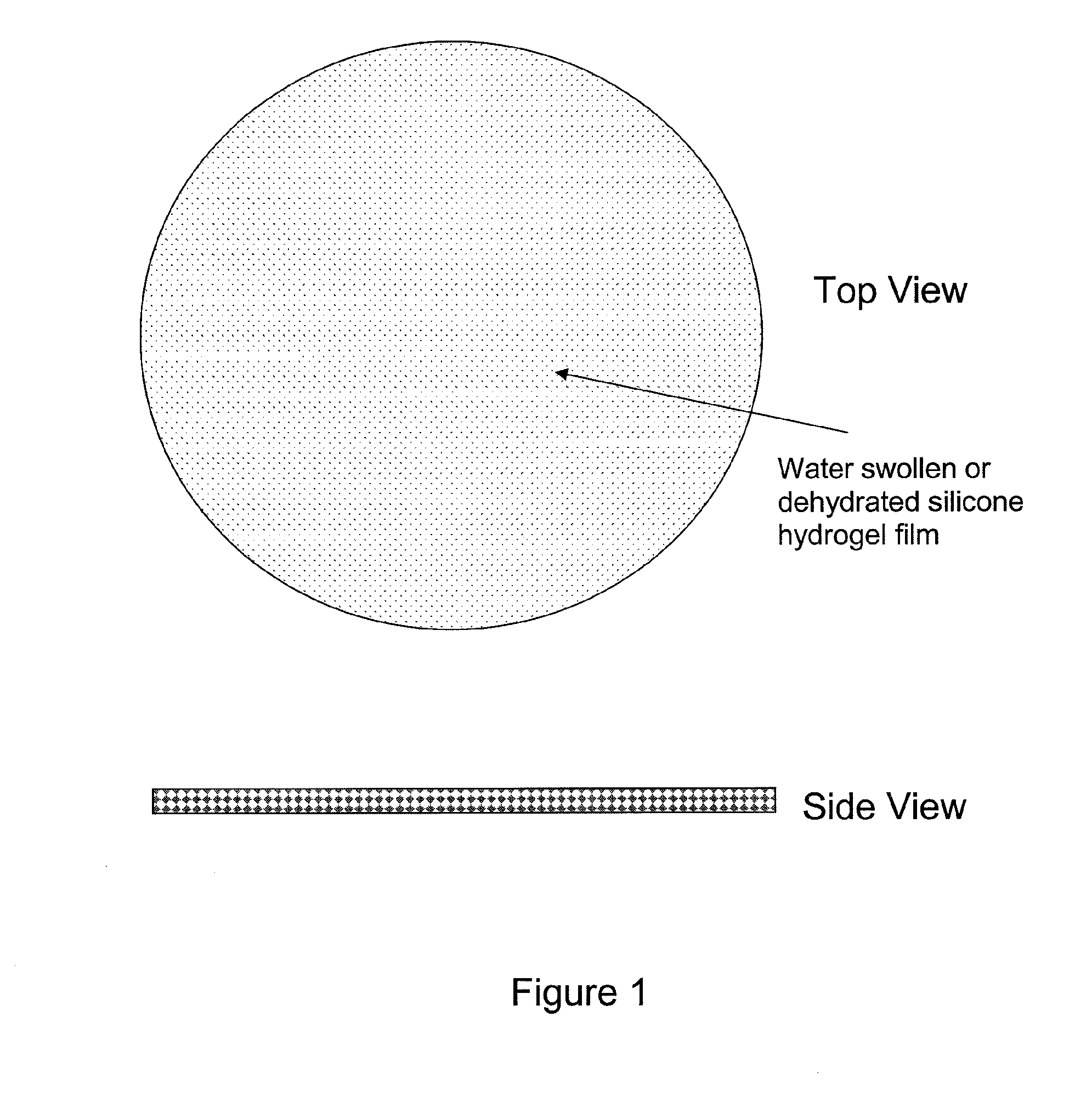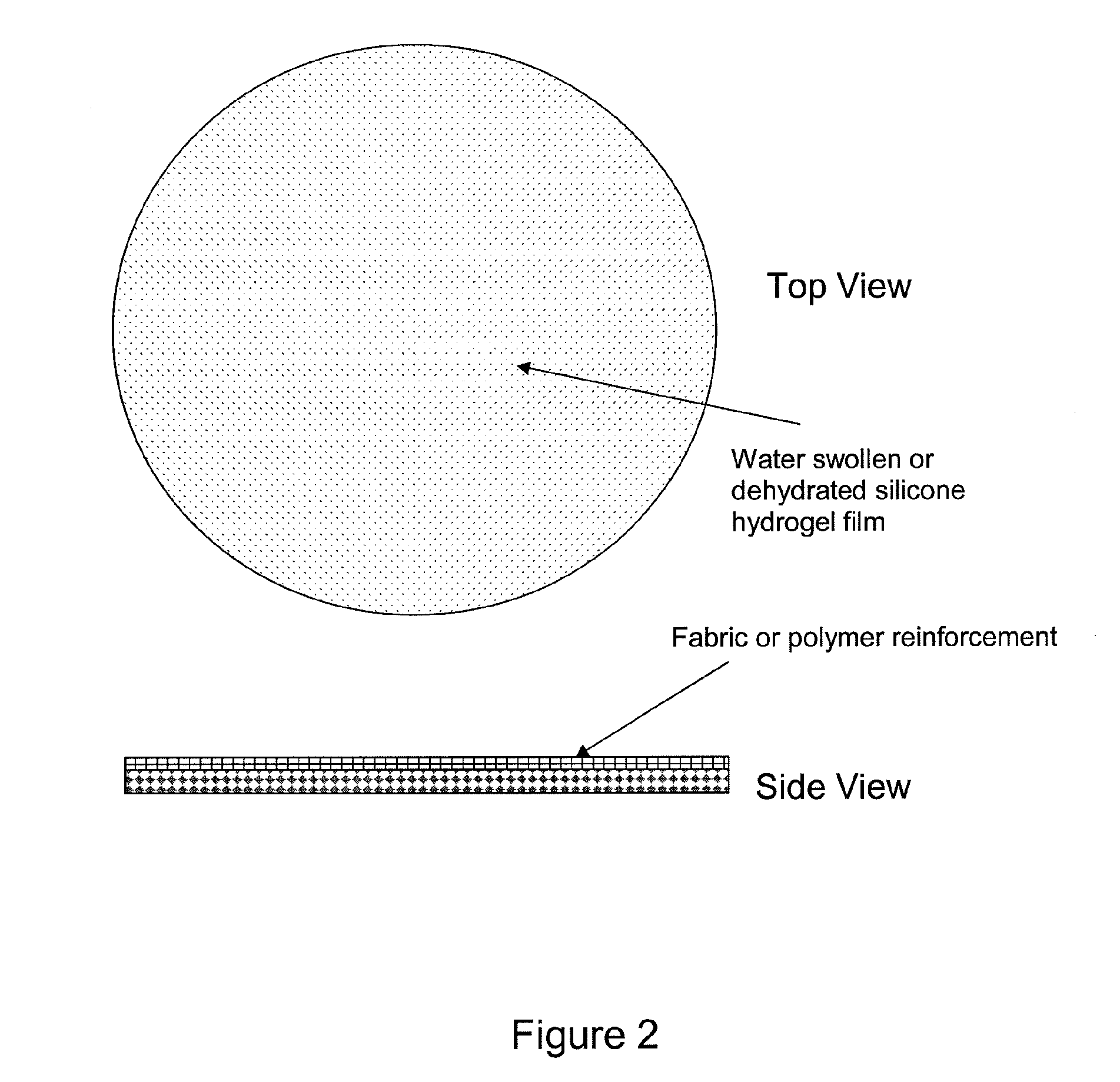Silicone hydrogels for tissue adhesives and tissue dressing applications
a technology of tissue adhesives and gels, which is applied in the field of wound care dressings, can solve the problems of localized hypoxia at the wound site, gauze or other wound dressings are extremely uncomfortable to be placed in contact with the eye, and many materials currently used in wound care are not optimized to be in contact with injured tissue, etc., to achieve the effect of cleaning the wound of waste products, promoting healing, and promoting healing
- Summary
- Abstract
- Description
- Claims
- Application Information
AI Technical Summary
Benefits of technology
Problems solved by technology
Method used
Image
Examples
example 1
Silicone Hydrogel Spray for 2nd and 3rd Degree Burns
[0066]A mixture of silicone hydrogel spray is composed of an initiator, difunctional PDMS methacrylate, DMA, HEMA, and TRIS with a spraying solvent.
IngredientWeight %Difunctional PDMS methacrylate25DMA15HEMA15TRIS20Alcohol / water24.9UV / Visible light initiator0.1
[0067]The hydrogel is sprayed onto a burn and allowed to polymerize over the wound under UV / visible light. Once polymerized, the hydrogel acts as an artificial skin and will provide a high moisture environment, oxygen permeability, and a barrier to infection. This method of wound care is superior to current bandages or wound dressings because it will provide an effective microbial barrier, prevent wound desiccation, and allow high oxygen permeability for tissue healing. The high oxygen permeability and moisture content will also help prevent scarring.
example 2
Silicone Hydrogel Spray for 2nd and 3rd Degree Burns
[0068]A mixture of silicone hydrogel emulsion spray is composed of an initiator, difunctional PDMS methacrylate, DMA, and TRIS.
IngredientWeight %Difunctional PDMS methacrylate25DMA30TRIS20Water24.9UV / Visible light initiator0.1
[0069]The hydrogel emulsion is sprayed onto a burn and allowed to polymerize over the wound under UV / visible light. Once polymerized, the hydrogel acts as an artificial skin and will provide a high moisture environment, oxygen permeability, and a barrier to infection. This method of wound care is superior to current bandages or wound dressings because it will provide an effective microbial barrier, prevent wound desiccation, and allow high oxygen permeability for tissue healing. The high oxygen permeability and moisture content will also help prevent scarring.
example 3
Silicone Hydrogel Spray for 2nd and 3rd Degree Burns
[0070]A mixture of silicone hydrogel emulsion spray is composed of an initiator, difunctional PDMS methacrylate, DMA, PVP and TRIS.
IngredientWeight %Difunctional PDMS methacrylate20DMA15PVP K-9025TRIS15Water24.9UV / Visible light initiator0.1
[0071]The hydrogel emulsion is sprayed onto a burn and allowed to polymerize over the wound under UV / visible light. Once polymerized, the hydrogel acts as an artificial skin and will provide a high moisture environment, oxygen permeability, and a barrier to infection. This method of wound care is superior to current bandages or wound dressings because it will provide an effective microbial barrier, prevent wound desiccation, and allow high oxygen permeability for tissue healing. The high oxygen permeability and moisture content will also help prevent scarring. The PVP molecules will be absorbed or washed away slowly to give a gradually increasing hydrophobic environment that provides a decreasing...
PUM
| Property | Measurement | Unit |
|---|---|---|
| water content | aaaaa | aaaaa |
| water content | aaaaa | aaaaa |
| water content | aaaaa | aaaaa |
Abstract
Description
Claims
Application Information
 Login to View More
Login to View More - R&D
- Intellectual Property
- Life Sciences
- Materials
- Tech Scout
- Unparalleled Data Quality
- Higher Quality Content
- 60% Fewer Hallucinations
Browse by: Latest US Patents, China's latest patents, Technical Efficacy Thesaurus, Application Domain, Technology Topic, Popular Technical Reports.
© 2025 PatSnap. All rights reserved.Legal|Privacy policy|Modern Slavery Act Transparency Statement|Sitemap|About US| Contact US: help@patsnap.com



